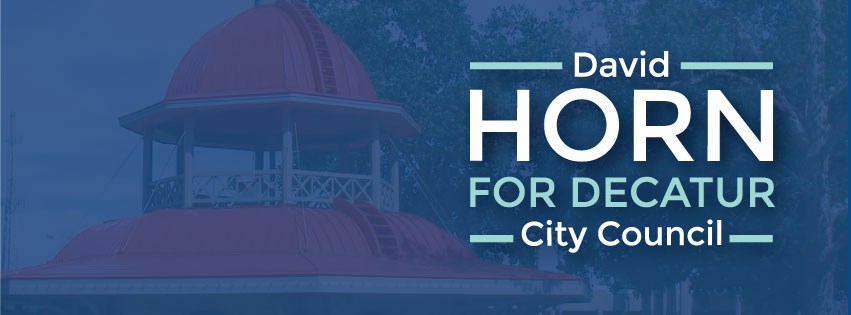
New TIF District added to Decatur
The Decatur City Council approved the creation of a new Tax Increment Financing (TIF) District at its meeting on May 6. The boundaries of the new Central TIF District are highly gerrymandered, but as a generalization, the district is located in the west-central area of the city and includes the downtown and Eldorado St. commercial corridors and the Neighborhood United residential area. The Central TIF District contains 2,080 buildings of which 1,603 (77%) are deteriorated and 200 buildings (10%) are delipidated. Furthermore, of the total 2,211 parcels in the new TIF, 458 (21%) are vacant.
Prior to the formal approval of the TIF district, the city sent letters to all property owners in the TIF and held two public hearings. I thank the dozens of citizens who attended the hearings. A large proportion of the attendees wanted to know more about how a new TIF district can result in increased assistance to improve their properties and the neighborhood in which they live.
The #1 general objective of the Central TIF Plan is “To alleviate blight, ensure safe conditions, and enhance the efficiency of the infrastructure networks.” Thus, residents should be optimistic about a new TIF in the west-central portion of the city. Furthermore, there may be no other economic development tool that is better suited to alleviate blight and ensure safe conditions than a TIF district. For this reason, I was supportive of the district’s creation. However, it is critical that the residents within the TIF hold the city council accountable to make sure the new TIF district meets its objectives.
EXPIRING OLDE TOWNE TIF HAD MIXED RESULTS
After 23 years, the Olde Towne TIF District expires at the end of the year. The Olde Towne TIF included the Central Business District, the Millikin Heights neighborhood, and the Oakwood Business District. Arguably, 2 decades later Millikin Heights and the Oakwood Business District are in worse shape than they were when the TIF district was formed. Twenty-three years later, the Central Business District is considered a tremendous asset that individuals are highly complementary of yet is still defined as blighted. Furthermore, downtown Equalized Assessed Value (EAV) decreased from $23.7 million in 2008 to $22.6 million in 2022 (data provided to council in January 2023), and taxpayers are paying $959,885 this year in bond repayments for the downtown infrastructure improvements made years ago. In addition, residents pay approximately $500,000 a year to maintain downtown parks, facilities, and infrastructure.
Millikin Heights continues to have an unacceptably high level of blight (blight score of 0.39 in 2022), saw a reduction in EAV from $23.6 million in 2008 to $20.0 million in 2022, and was one of only 5 neighborhoods to see an increase, albeit 1%, in crime between 2020 and 2022 (data provided to council in January 2023). Qualitatively, I have heard more concerns about neighborhood safety from Millikin students living in Millikin Heights the past few years, than I heard in my first 15 years at the university. Thus, if a TIF District is designed to alleviate blight and ensure safe conditions, the Olde Towne TIF is not a model to follow.
ALLEVIATING BLIGHT IS A PUBLIC SAFETY ISSUE
The city council must do a far better job of alleviating blight and ensuring safe conditions within the Central TIF District than what was accomplished with the Olde Towne TIF District. The work done in the Johns Hill neighborhood demonstrates that reducing blight reduces crime and thus, citizens should not have to wait another 23 years to see the positive effects that TIF districts can bring. For example, the city could issue a bond in the near future to remove the blight in the area, make improvements to properties, and enhance green spaces. This could be done simultaneously to issuing bond funding for commercial projects such as a proposed parking garage adjacent to the Barnes Citizens buildings.
WHAT IS A TIF DISTRICT?
TIF stands for Tax Increment Financing. According to the Illinois Municipal League Fact Sheet (https://www.iml.org/file.cfm?key=18431), “TIF is a mechanism for municipalities to spur economic development in specific geographic areas that are blighted and deteriorating. … local taxing bodies create a TIF redevelopment project area, or TIF district, whereby the Equalized Assessed Value (EAV) of the property in the area is set at a base amount. … The growth of the EAV of property within the TIF district (the increment) is collected into a special fund for use by the municipality to make additional eligible investments in the TIF project areas.” Before a TIF district can be established, the municipality is required to identify the economic and physical failings that are to be corrected, and TIF funds can be used for projects such as property demolition and renovation. The maximum duration that a TIF district can last is 23 years with the option of extending an additional 12-24 years pending approval of the Illinois General Assembly.
